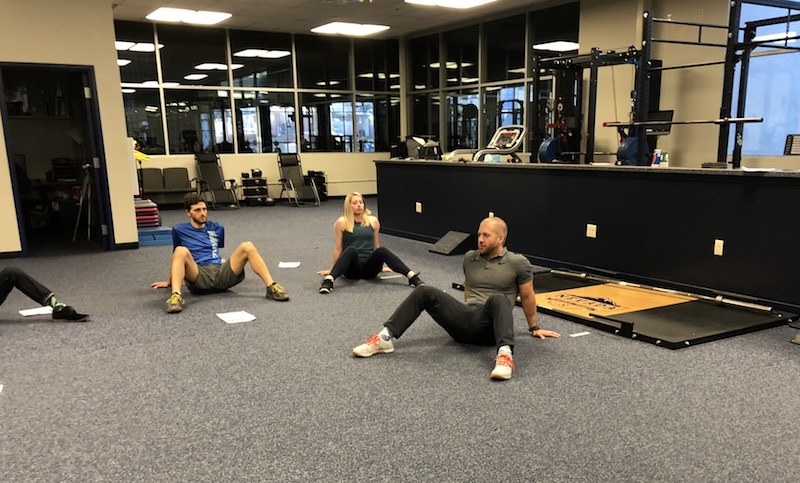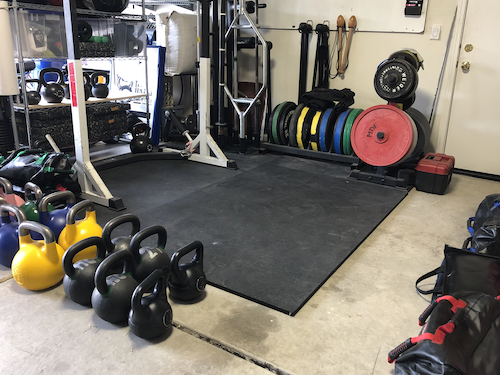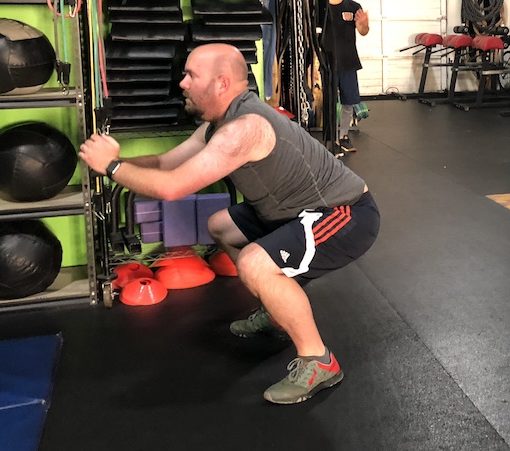A few weeks ago, I attended a Strength Training for Endurance Athletes Workshop at Nevada Physical Therapy. It was about 2 hours long with both a lecture and a practical component. It was lead by Jonathan Hodges, a competitive, national-level powerlifter, and co-owner of Nevada PT, and Matt Pendola, a local Licensed Massage Therapist, corrective strength and running coach. We covered quite a bit in the workshop so I am going to break down what we covered into the following three posts:
This post will cover what was in the workshop. Since it was at NVPT, the majority of the workshop covered their tendinopathy protocol, and the anatomy, physiology, and biochemistry behind that protocol.
In the second post, I’m going to go meta on you and answer the question why, besides injury recovery, an endurance athlete should add strength training to their training.
Finally, I will add my own interpretation of a generic program for an endurance athlete with minimal orthopedic issues as an exercise for myself and to show the interested athlete what it would look like to add strength training to a running/cycling/triathlon program. For the athletes I have trained, the program will look familiar but I have changed some things based on what I learned in this workshop.
I decided to break this into pieces because I want readers to be able to easily separate my editorializing about what was covered and what was actually covered in the workshop. My hope is that by the end of this series of posts, both athletes and coaches will have a more complete understanding of the structure and function of their body and also a clear idea about how create a program that is effective, efficient and based on sound research and clinical experience.
This is going to be a long one so TL;DR summary below…
The Workshop:
There are two pieces of information the reader will need to know to give context to this workshop. Much of the data, and most importantly, the research foundation for the protocol can be found in the following two documents. The first is a literature review, “The Effect of Strength Training on Performance in Endurance Athletes” by Beattie, et al. And the second is encapsulated in the video “Jill Cook – Current concepts in tendinopathy rehabilitation” and the longer, more thorough, “Why and How Exercise is the Best Treatment for Tendinopathy.” The Beattie literature review makes the point that in the past, maximal oxygen uptake (VO2 max ) and lactate threshold (LT) have been used in the laboratory to predict the performance endurance athletes. Currently however, economy, velocity/power at maximal oxygen uptake and endurance-specific muscle power tests (i.e. maximal anaerobic running velocity; vMART) have been shown to be better indicators of race performance. The clinicians at Nevada PT, correctly in my opinion, make the assumption, if these are the best metrics, then preparation for return to play (RTP) should be geared towards making positive changes in those metrics. You will notice that these metrics have a strength component and the Cook video and paper make the case that to appropriately rehab tendons (and probably many other issues athletes would see a Physical Therapist for) requires some sort of heavy loading (Spoiler alert: Heavy is starting at 3 sets at 15 reps progressing over 12 weeks to 4 sets at 6 reps. Not that heavy within the context of traditional strength and conditioning but if you are stickler for technique and movement quality you’ll definitely be fatigued when you finish your sets). Finally, if you just want the actual PowerPoint it is here.

Hypothetical Venn Diagram showing where endurance and strength training intersect.
What’s the Problem, Statistics on Injuries
Of the injuries facing endurance athletes, bone (e.g. stress fractures, etc.), tendinopathy, joint injuries, and muscle strains, the workshop focussed on tendinopathy. It is estimated that tendon injuries are 30-50% of all sports injuries. More importantly, about 50% of the injuries suffered by endurance athletes, are tendon related. Conversely, only 6% of sedentary individuals are affected by some sort of tendinopathy. Specifically, Achilles tendinopathy is estimated at 55-65% of all Achilles’ tendon disorders (from Heavy Slow Resistance Versus Eccentric Training as Treatment for Achilles Tendinopathy by Beyer, et al.)
Dr Hodges says there are roughly 5 different issues they see at NVPT in conjunction with most endurance athlete injuries. These issues are what they try to address in injury risk reduction (in no particular order):
- Weak lateral chain
- Decreased hamstring strength
- Asymmetrical Hip Internal Rotation (In flexed hip and extended hip are both addressed in assessment and treatment)
- Achilles Tendinopathy
- Inappropriate workload management (We cover this quickly below, but for a more detailed explanation within the context of endurance training, see this blog post.)
Tendon Science
- Tendons connect bones to muscles and deliver the force created by muscles to bones. Tendons may or may not cross a joint.
- Tendons are amazingly strong and take time to both get injured and to recover from injury. While the majority of studies test a protocol over 12 weeks, full recovery can take up to a year or longer. One of the issues that makes recovery problematic is that athletes are often re-injured when returning to play.
- Tendons are “viscoelastic,” sometimes they have elastic behavior (i.e. they “sprng” back to original shape, when deformed/stretched) and viscous behavior (i.e they change shape when deformed/stretched). See this video for a great visual demonstration.
- Normal, healthy, tendons are made up of regular (i.e. organized) collagen fibers, elongated tenocytes (the cells that make up the collagen fibers) and minimal innervation and vascularity. Abnormal tendons tend to have irregular collagen fibers, ovoid/rounder tenocytes and increased innervation and vascularity. What is most important about these facts is that these changes are biochemical in nature and often do not exhibit warning symptoms of something worse to come. Here is more information on tendons than you will ever need in case you get hooked on tendons like I did.
- Two types of loading for tendons: Cyclical (running, cycling, jump rope, etc.) and Mechanical (i.e. strength training)
- From my notes, tendons need about 36 hours between cyclical exercise otherwise they tend to make the structural and biochemical changes that are found in abnormal tendons.
- If caught early enough, abnormal tendon structure can be repaired.
- In the Jill Cook video (5:00 – 8:00), she points to research that says even though a tendon may be injured (i.e. structure changed), and probably won’t ever regain it’s original structure, the athlete still has plenty of good tissue to train, i.e. you can change the function for the better. She says “Train the doughnut [good tissue], not the hole [damaged tissue].”
Spectrum of injury and chances of re-injury on RTP

There are two nuggets of research that were helpful in this workshop. The first was Jill Cook’s notion of the spectrum of injury (see above). This was interesting because it shows that even though you may not have tendon pain, but you could still be loading your tendons inappropriately and setting yourself up for injury. The second was Blanch and Gabbett’s Model of Acute:Chronic loading as a factor of re-injury. The chart below is really just another way of showing how long tendons, really kinetic chains, take to heal thoroughly. These two pieces of research, combined with the science shown above show why rehab from even a moderate case of tendinopathy can take 3 months or, probably, more.

Example of Acute:Chronic workload:
Workload ratio = External Load (reps) x Internal Load (time) x Rate of Perceived Exertion (RPE)
Example: 3 sets x 15 reps, 5 seconds, 8 RPE = 1800 units this week
Injury rate increase at 150% of (i.e. if this week is 1800, keep load below 1.5 x 1800)
Keep the Acute:Chronic workload in a safe range by following something that looks like the Beyer or Heavy Slow Resistance (HSR) Protocol
Week 1: 3 x 15 rep max (RM)
Weeks 2 & 3: 3 x 12 RM
Weeks 4 & 5: 4 x 10 RM
Week 6 to 8: 4 x 8 RM
Weeks 9 -12: 4 x 6 RM
Notes:
- 2 – 3 min rest between sets
- RPE of 8 on last 2 reps (i.e. you feel like you can do another 2 – 3 reps – For Mad Dawg athletes reading this, it should feel like a “Get It Done” workout)
- 3 – 5 second concentric and eccentric contraction (For Mad Dawg athletes, this would be like our tempo strength workouts, and would be something like 3131, that is 3 secs down, 1 sec at bottom, 3 secs up, 1 sec at top)
- As a strength coach, a 15 rep max isn’t that useful, but as I remember the Dr Hodges saying, this means start out light and make sure the athlete is doing good reps. When they get to about 8 RPE and you are at about 12 reps, you guessed right on the weight. Adjust as necessary. Again this is probably going to be a long process, err on the side of too easy, you’ll have plenty of time to adjust upwards.
- This is not a one-size-fits-all program, Dr Hodges said that often there will have to be an ”accumulation” phase that lasts 4 – 8 weeks. From what I can tell, there is quite a bit of coaching that goes on to make this protocol work.
- HSR protocol is something that is fairly new and seems to be as effective as the traditional eccentric loading protocol, but is more time efficient and has better patient satisfaction (at least in the short run). I would also guess that because it “looks” like exercise, it is easier to get compliance with athletes.
- If you are a strength coach and you want to help an athlete, in conjunction with a licensed medical practitioner, who has some sort of tendinopathy, you really need to read this. Yep, that is the third time I’ve linked to it.
Nevada PT Return to Play Criteria
- Single, Triple, and Crossover Hop Test
- International Knee Documentation Committee (not sure about this, possibly a check list, still need to research this)
- T-test sub 11 sec
- Side Plank Hip Abduction reps/30 or 60 seconds greater than 90% of Unaffected Leg
- No more than 1 DN (dysfunctional non-painful) score on SFMA
- Anterior Y-balance greater than 90% of score/distance on affected leg.
- Acute:Chronic ratio of sub 1.5 of normal in-season load (this is tricky as the athlete starts returning to sports and is mixing exercise types/modalities but essentially it means go easier than you think. Again, due to the occurrence of many injuries when returning to play, a coach will be a big asset here.)
Summary:
Athletes injure their tendons most often by chronically exceeding the tissue’s maximum recoverable volume, and conversely, athletes repair tendinopathy by steadily and progressively increasing ROM and load. At the highest level, it is the appropriate movement pattern and the time under load over weeks and months that is both the poison and the cure. Choose wisely.
If this post was helpful to you, and you were able to incorporate one thing into your practice immediately, please post what it was in your comment below.




2 thoughts on “Strength Training for Endurance Athletes – Nevada PT Workshop”
I found it helpful to see the supporting rationale behind the claim that recovering from a tendon injury can take months. (I’ve been told that by my coaches for decades, and as an athlete I’ve always wanted to believe that they were just being ultra-conservative.)
The funny thing is that I have a health care practitioner friend and she had an injury. She said, I tell my patients it’s six weeks, but I think it’ll take me 3 weeks to get back to training. Everyone thinks recovery estimates are over estimated. But I like this clinics way of addressing recovery because they work the athlete pretty hard if they have the capacity.